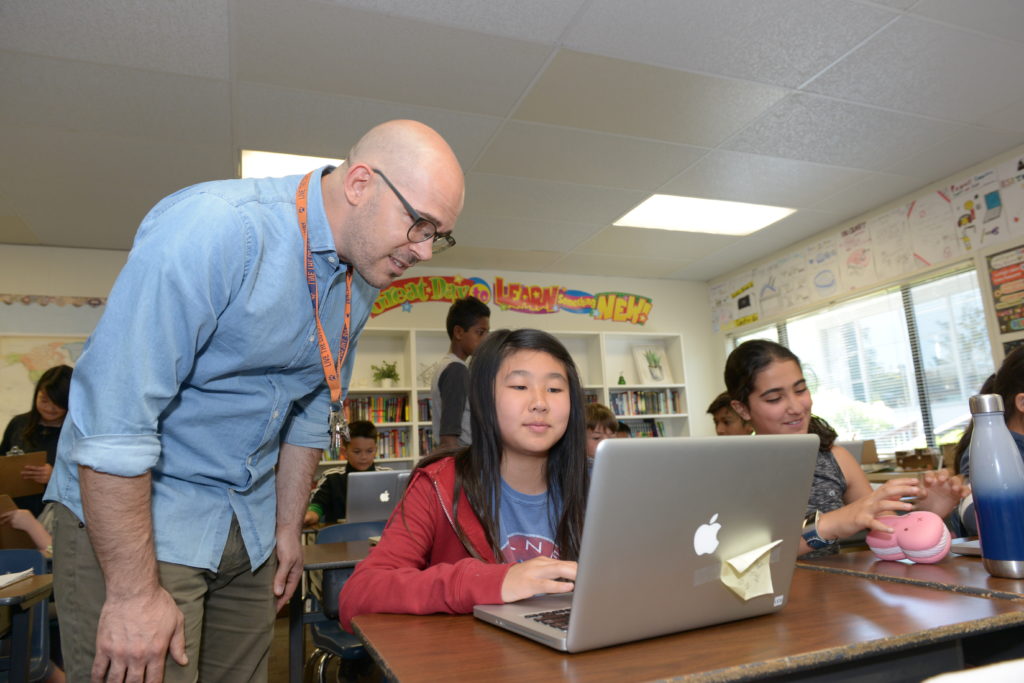Every day, middle school teacher Alyson Hoberecht reminds
herself: “Students take on the characteristics of the teacher they’re with each
day.” Then she asks, “Who am I teaching my students to be?”
Hoberecht is not alone in being mindful of her important
role. Every day in classrooms throughout California and across the country,
educators spark fire in the minds of eager (and sometimes not so eager)
students. It’s this commitment to conveying knowledge, creating opportunity and
cultivating wonder that unites educators and inspires the quest for more
effective and efficient ways to teach.

We collected best teaching practices from several remarkable
educators who recently presented at CTA’s Good Teaching Conference on important
and timely topics, including student engagement, multicultural awareness in the
classroom, and combatting bullying. These tips can provide helpful information
and useful context to situations and challenges educators face in classrooms
statewide.
Engage students to help them reach their full potential

Jon Pearson, Los Angeles-based learning skills consultant, author, educator
Here’s a foolproof way to motivate anyone. I have students
take a piece of paper and make three columns. At the top of the first column,
they write “FUN” and list everything they do for fun (just key words). In the next
column, they write “EXPERT” and list everything they are good at or wish to be
good at. At the top of the third column, they write “HEROES/SHEROES” and list
anyone (living, deceased, fictional, cartoon, pets) they admire. I tell
students to go beyond rock stars, sports figures and entertainers.
Everyone is motivated by three things: pleasure, mastery and
values. This is an easy way to discover what those things are specifically.
Have students add to their lists throughout the year and keep a copy of the
lists in your desk (especially for the students with whom you have the most
challenges). If a student has a hard time making any of the lists, it just
shows areas that need attention. At the heart of “who you are” is what lights
you up. Knowing that is an essential first step, because people don’t really
listen with their ears — they listen, ultimately, with their passions.
Drawing is the easiest way to get, keep and direct
attention. I was a substitute teacher in the Los Angeles juvenile hall system
for two years. I got students to look up at me by drawing. Coercion never
works. Curiosity always does. You might lose five minutes by drawing a picture,
but if you draw a picture and talk from it, you can double the amount of work
you get done over the next block of time. Engaged students get more done,
faster.
Use mindfulness to make the classroom climate safer

Teresa Tolbert, 14-year high school English teacher, mindfulness coach; San Juan Teachers Association
I meditate with students. I explain the benefits and show
them the way to prepare for meditation — the importance of long inhalations and
exhalations, a strong, straight spine and engaged core, feet flat on the floor,
and what to do with their hands and their gaze. I explain that it’s optional,
but anybody who wants to try it should not be disturbed, stared at or mocked.
Students who opt out are asked to put their heads down on their desks, read a
book or do something quiet. Students ask for meditation and understand its
benefits when they are anxious or stressed about upcoming tests, deadlines, or
just life. All of this can be modified for younger students and has been done
with great effects for years by many experienced practitioners.
I ensure my room is safe emotionally by setting norms early
in the school year and through team-building and rituals. I also make it safe
for students to share with me privately through journaling and what I call
“anxiety busters.” Students can share with the class in a supportive
environment where positively reinforcing each other is constantly recognized. I
affirm students and “see” them as often as possible. This is the tricky part,
especially with large class sizes.
If students feel relaxed, assured, affirmed and seen, they
are more willing to take cognitive risks and use their voices in discussions.
My classroom is not teacher-driven. I give them the tools and the safety to be
the directors of their own learning. We have a lot of voice-building exercises
such as MicroLab, literature circles and Four Corners, where every voice is
heard and everybody has air time.
Use project-based learning and games like Minecraft to engage students

Chris Hazelton, sixth-grade social studies and ELA teacher; Los Altos Teachers Association
Let the students lead: The students are experts about most
gaming platforms, especially Minecraft. Let students give ideas, help monitor
other students, and troubleshoot technology issues.
Focus on collaboration: Rather than making the gaming
individual, make it a collaborative effort by assigning tasks that require the
students to work together and problem-solve.
Start with research: The motivation to be able to
participate in a Minecraft-based project can propel students who are reluctant
to research to look up ideas, details and other information for their projects.
These opportunities can allow the teacher to promote research skills like
evaluating sources, finding text evidence and analyzing key details.
Provide choice: Allowing students to choose how they want to
represent their thinking in Minecraft takes pressure off the teacher to come up
with the perfect project. The students get to propose how they would like to
demonstrate their thinking about the topic.
Require work completion: If you have students who are very
interested and motivated by using gaming platforms like Minecraft, you can
often get them to complete missing assignments before they get to participate
in the project.
Create and maintain a bully-free classroom environment

Todd Migliaccio, professor of sociology, director of graduate studies; California Faculty Association, CSU Sacramento
Through class discussion, establish classroom rules and
community (class) agreements. These are posted in the classroom for easy
reference. Then be consistent with these in how you interact with students and
model the behavior. Some can be subjective, like treating one another
respectfully, but that means having a conversation about what that means, and
again, including students’ voice. This all relates to how they treat one
another in general, as well as how to act during class discussions.
Half-hour weekly class discussions about safe and inclusive
environments allow students to share and engage with ideas that can be
difficult to discuss. Facilitate discussion and maintain a focus on more
positive interactions. Focus on key issues, such as telling vs. tattling
(ratting, snitching). Let them introduce their thoughts so they know they have
a safe space to discuss issues, their voice matters, and all are in agreement
about what is expected.
Connect students to the class. This limits the impact of
bullying, increases the likelihood of students informing teachers, and helps to
create a positive culture for learning. Students who have conversations with
teachers other than about academics are more connected to school. This includes
highlighting successes in the classroom, which makes the classroom theirs and
not the teacher’s alone. Just knowing each student’s name and activities they
do outside school is impactful.
Raise multicultural awareness in the classroom

Angela Der Ramos, elementary school teacher; Alisal Teachers Association
Acknowledge that the way we look affects the way we move
through the world, which in turn affects our experiences, outlook and ways of
being. Despite civil rights putting an end to legal segregation, many of us
live or work in a segregated community. If you teach children who do not look
like you, it is important to understand the impact of racial narratives that
affect all of us. Children learn from what they see. We often see kids idealize
and emulate heroes in media. If a child never sees a hero who looks like them,
what is the implicit lesson learned? This is why teachers of color have great
impact on students of color. Whether you are the same color as your students or
not, examining your own experiences and biases is a basic premise in equity.
Provide those heroes. Be mindful and inclusive of the
protagonists in the books you use in your classroom. Most traditional popular
protagonists are white males.
Not all representation is equal, so teach critical thinking
and media literacy. Just as much as children and adults see heroes in the
media, the opposite is true. If the only thing they know about Central
Americans is what they hear on TV, many will believe that all Central Americans
are MS-13 gangsters. Going deeper into understanding an author’s purpose is
absolutely appropriate in this case, as is teaching about point of view.
Learning that there are multiple ways to interpret or experience the same event
helps students to navigate and accept differences.
Have consistent expectations and create a safe culture

Alyson Hoberecht, middle school math teacher and AVID coordinator; Garden Grove Education Association
Connection: The more we know about our students, beyond a
test grade or homework assignment, the more they begin to care about themselves
and their success. They also begin to believe in themselves and care about
others.
I often share my passions, successes, struggles and growth. As I model my own
vulnerability, I enable my students to share elements of themselves. I assign
real-world “concept connection projects” throughout the year. Completing these
projects lets them prove their academic knowledge in a creative way and reveals
what they are most passionate about in life.
Consistency: When challenges arise with students, I say:
“How can I help?” I hold silent space for them to think and respond privately.
I actively listen to what they are willing to share. I remind them of my
expectation to receive the same in return, and then offer two good choices. As
students feel a repeated pattern of care mixed with consistent expectations,
they feel comfortable and empowered.
Culture: I often say, “Mistakes are welcome” in class when students share an incorrect or incomplete answer. These words enable me to create a safe culture in our classroom.
As students complete their work, they know the expectation is that they will bring a question or point back to class the next day. This reminds that questions and collaboration are the avenues to true appreciation and understanding. I celebrate and offer thank-you notes when students ask great questions or share high levels of thinking.
The Discussion 0 comments Post a Comment